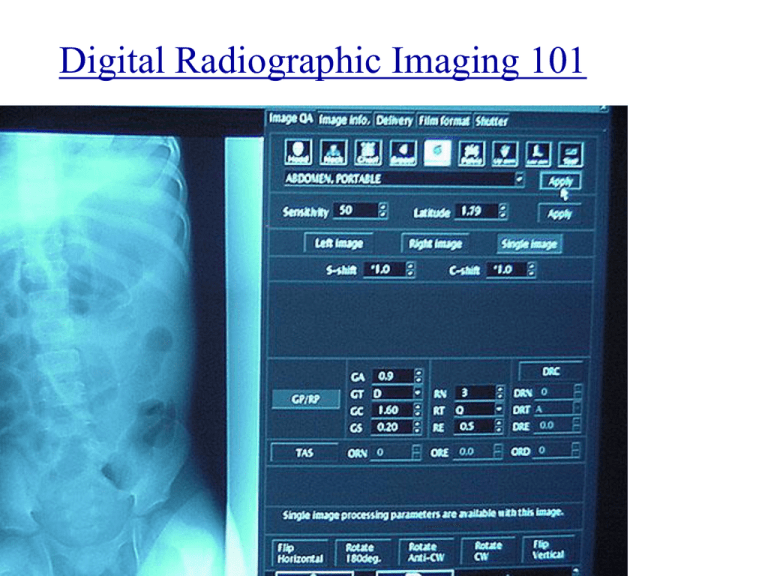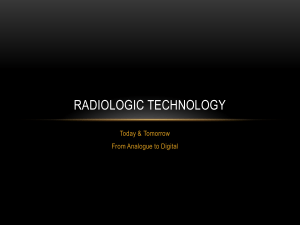Digital Radiography
advertisement

Digital Radiographic Imaging 101 Terms Digital radiography (DR), image receptors, film digitizer, noise, signal to noise ratio, area beam, xenon gas detectors, scintillation detectors, fan beams, pre and post patient collimation, slit radiography, translation, interrogation time, attenuation profile, extinction time, Computed radiography (CR), photostimulable phosphor image plate, barium fluorohalide, europium, IP reader, photomultiplier (PM) tube, photocathode, photoemission, dynode, CR workstation, linear energy response, duel image format, charged couple devices (CCD), amorphous silicon & selenium image receptors, thin film transistor (TFT), active matrix array (AMA), direct radiography. Digital Acquisition Methods 1. Digitize radiographs with a film digitizer Similar to a paper scanner, only for film Film is read by a laser and the image file is sent to a designated secondary device Uses * Converts films to digital files * Teleradiology * Teaching files and presentations Advantages * Inexpensive * Easy to use * Small Disadvantages * Conversion of analog to digital adds a step that degrades image quality * Impractical for converting large archives Digital Acquisition Methods 1. Digitize radiographs with a film digitizer 2. Digitize the video signal with an ADC Advantages: Inexpensive Easy to install Disadvantages: Noisy cameras Poor signal-to-noise ratio (SNR) Area beam (Scatter) Small matrix size (525) Digital Acquisition Methods 1. Scan radiographic films 2. Digitize the video signal 3. Scan projection radiography (SPR) * Greatly reduces the area of the beam, and scatter * Replaces the camera with detectors Fan shaped beam Depth of beam may be a cm, or smaller Xenon Gas Detector From a CT Scanner Xenon gas chamber Ring of Xenon Detectors in a CT Scanner Detectors SPR used for CT Scout Films Stationary X-ray tube Detectors CT Scout Views Acquired by SPR, to produce a digital radiograph Scatter radiation is greatly reduced Detectors 1. Xenon Gas 2. Scintillation Detectors 1. Xenon Gas 2. Scintillation Crystal Photomultiplier (PM tube) Digital Acquisition Methods 1. 2. 3. 4. Scan radiographic films Digitize the video signal Scan projection radiography (SPR) Computed Radiography (CR) Photostimulable image plate (IP) technology Barium Fluorohalide doped with Europium CR Advantages Uses existing radiographic hardware So is relatively inexpensive to purchase Reduced number of repeats Increased latitude Filmless capture The CR IP looks like a conventional intensifying screen, and is housed in a conventional looking cassette. CR Facts 300 RSV Only one speed (no detail or high speed) Standard film sizes Laser Film – wet or dry processing Computed Radiography Step 1. Make the exposure like any other radiographic exposure, only use an IP instead of film. *Remnant photons strike plate *Photoelectric interaction causes barium fluorohalide to fluoresce as electron is ejected. *Electrons (that are of no more use in film radiography) are trapped in the energy traps created by the europium IP Reading the IP Converting the stored energy to an electric current, point by point. CR Workstations Problems Inherent to Conventional Chest Radiography Underexposed Posterior bases obscured by diaphragm on PA Retrocardiac clearspace overexposed CR Film Latitude Maxed out Logarithmic response of film Linear response of CR Yet to respond Analog is continuous. Image is fixed in film Digital is discrete. Image may be manipulated 15 1 15 1 CR Postprocessing & Characteristic Curves Histogram Processing Algorithms Poorly exposed image plates may be corrected by software to some extent Patient Dose Calculated and displayed Total energy absorbed by IP Fuji S number (200 ave) Low number = high exposure Kodak (1800-2200) Low number = low exposure Cassetteless Readers Chest units. In table Laser, Dry Image Hardcopy Devices Digital Acquisition Methods 1. 2. 3. 4. 5. Scan radiographic films Digitize the video signal Scan projection radiography (SPR) Computed Radiography (CR) Charge Coupled Devices (CCD) Charge-Coupled Device (CCD) CCD’s have replaced the Vidicon tube in camcorders Charge-Coupled Device (CCD) Read-out row Photoelectric detectors embedded in layers of silicon Each pixel is 6 to 25 microns in size, and can store 10,000 to 50,000 electrons. Charge-Coupled Device (CCD) …......... .. .. .……. …….. .. . ..... .… . ......... .. .… ……. …......... . ..... .. ..… .. .. . . . ……. . . …......... .. .. .……. …….. .. . ...... ..… . . .. .. . . … …. .. .. . ......... .. .… ……. …......... . ..... .. ..… .. .. . . . ……. . . …......... .. .. .……. …….. .. . ...... ..… . . .. .. . . … …. .. .. .. .. .. . . . . .. . … .. .. . . . ……. . . Incident light creates a charge in the pixels Charge-Coupled Device (CCD) …......... .. .. .……. …….. .. . ..... .… . ......... .. .… ……. …......... . ..... .. ..… .. .. . . . ……. . . …......... .. .. .……. …….. .. . ...... ..… . . .. .. . . … …. .. .. . ......... .. .… ……. …......... . ..... .. ..… .. .. . . . ……. . . …......... .. .. .……. …….. .. . ...... ..… . . .. .. . . … …. .. .. .. .. .. . . . . .. . … .. .. . . . ……. . . A shutter closes to stop further interaction of light on the pixels The frame is ready for reading Charge-Coupled Device (CCD) Charges shift from one pixel to another as they move to the readout row Charge-Coupled Device (CCD) Charges shift from one pixel to another as they move to the readout row Charge-Coupled Device (CCD) Charges move along the readout row, and exit the chip. Charge-Coupled Device (CCD) Charges move along the readout row, and exit the chip. Charge-Coupled Device (CCD) Question: When the charges leave the CCD chip, where do they go? Charges move along the readout row, and exit the chip. Answer: If the CCD was functioning as a camera, they could be sent directly to an analog monitor as the video signal, or... Charge-Coupled Device (CCD) ALU ADC ADC CU Primary Memory or...they could be sent to an ADC, on to RAM, (RAM) displayed on a digital monitor, and stored in a secondary memory Secondary Memory device DAC Digital Acquisition Methods 1. Scan radiographic films 2. Digitize the video signal 3. Scan projection radiography (SPR) 4. Computed Radiography (CR) 5. Charged Couple Devices 6. Flat Panels Amorphous Silicon & Amorphous Selenium Thin film transistors (TFT) in an Active Matrix Array (AMA), are incorporated in a “flat panel” detector that is used in place of a film cassette. Thin Film Transistors (TFT) 139 microns (half a hair) Diodes connected to rows Current flows out columns Amorphous Silicon Cesium iodide (CsI) scintillator converts X-rays to light Light is converted to a charge by a photodiode at a TFT junction. Amorphous Selenium (called Direct Radiography) Positive charge ++++++++ Electrode with a bias voltage Photoconductor material Photon in ----------Negative charge TFT Interaction creates electron-hole pairs Signal out Digital Radiography (DR) Receptor Video Target of camera SPR Xenon Reader* Energy Transformations CR Photostimulable phosphorIP CCD IC Amorphous silicon TFT AMA Flat panel x-ray to light to charged globules to video signal Interrogations of x-ray to ionized successive detectors electrons Interrogations of x-rays to light successive detectors to current Helium-neon x-ray to light to laser to trapped electrons to light to current Point by point discharge x-ray to light to of photoelectric trapped electrons detectors (pixels) to current point by point discharge x-ray to light of TFTs to current Amorphous selenium TFT AMA Flat panel point by point discharge x-ray to current of TFTs Scintillation Electron gun * Method by which the stored, latent electronic image is discharged Comment Use limited by noise of camera Dedicated cxr and CT scouts Only portable receptor Potential next generation of IIs Called direct radiography Called direct radiography





